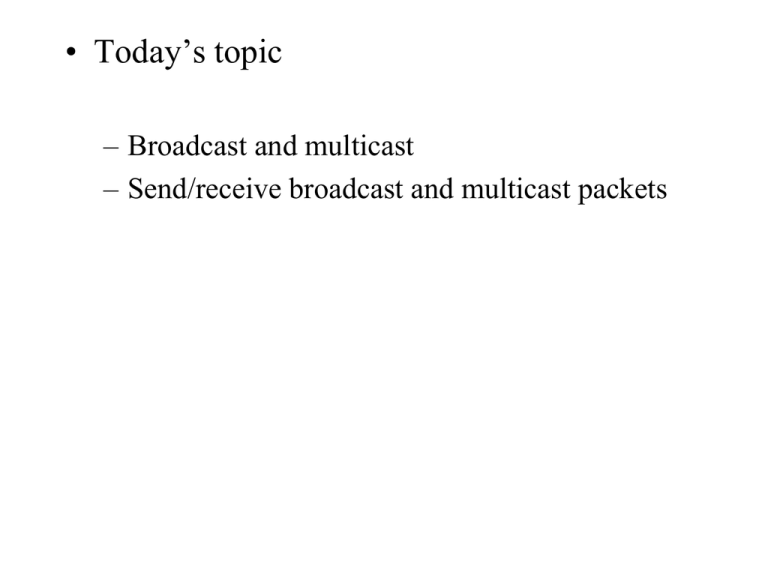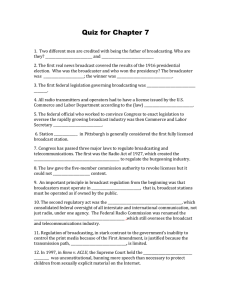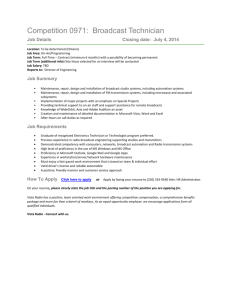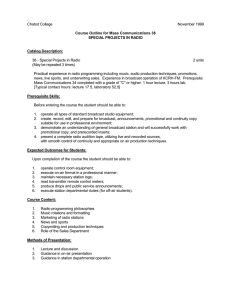• Today’s topic – Broadcast and multicast
advertisement

• Today’s topic
– Broadcast and multicast
– Send/receive broadcast and multicast packets
Types of IP addresses
• Unicast
– Identify one host
• Anycast
– Identify one host in a set of hosts
• Broadcast
– Identify all hosts
• Multicast
– Identify a set of hosts
• Broadcasting and Multicasting
– An area that is not well standardized – systems
from different vendors may behave differently
when dealing with broadcast and multicast
packets.
• May not work on WAN (some equipment along the
path may not support broadcasting/multicasting).
• Usually work on LAN (e.g. Ethernet) – no router in
between.
• Broadcasting
– IP broadcast address:
• IP address can logically be viewed as three
components: <netid, subnetid, hostid>, e.g.
• When the hostid contains all one bits
111111111…111, it is a broadcast address, let us
denote the all one bits as –1.
• two kinds of broadcast addresses:
– Subnet-directed broadcast address: <subnetid, -1>
– Limited broadcast address < -1, -1> or 255.255.255.255,
broadcast to all machines in the local network.
– Router typically does not forward subnet-directed
broadcast address
– Router should not forward limited broadcast address
• Broadcasting
– Ethernet broadcast address:
• Ff:ff:ff:ff:ff:ff
• All Ethernet cards recognize this address
– What happens when a broadcast packet is sent
in a LAN?
• The packet will go up all the way to the IP layer on
ALL machines!!
– Implication?
• Ethernet switches must support broadcast
– Many applications are built on top of it. ARP, BOOTP
– ATM LAN must emulate this capability.
• Sending a broadcast message:
–
–
–
–
Set the SO_BROADCAST option.
Set destination ip address to 255.255.255.255
Different system may behavior differently.
See example1.c
• Receiving a broadcast message:
– Nothing extra
– Be very careful when using broadcast, you
might affect other people on the same
network without knowing it.
• Multicasting (send to many):
– In between unicast (send to one) and broadcast (send to
all).
– IP Multicast address
• 1110 xxxx.xxxxxxxx.xxxxxxxx.xxxxxxxx (224.0.0.0 to
239.255.255.255)
• These addresses are associated with a group of interfaces.
– A host must explicitly join and leave a group.
– Ethernet multicast address:
1110 xxxx.x xxxxxxx.xxxxxxxx.xxxxxxxx
–
------------------------------- 23bits
– 01. 00. 5e. 0 xxxxxxx.xxxxxxxx.xxxxxxxx
• Imperfect filtering
• Some special multicast addresses:
– 224.0.0.1 -- all hosts group
– 224.0.0.2 – all routers group
– 224.0.0.0 – 224.0.0.255 are reserved.
• Sending multicast messages:
– Use sendto, just treat a multicast address as a
regular IP address.
– Can control the number of hops for multicast
packets by setting IP_MULTICAST_TTL
– Can avoid loopback by turning off
IP_MULTICAST_LOOP.
– See example2.c
• Receiving multicast message:
• After binding a socket to a port, the socket must join
the group (setsockopt,IP_ADD_MEMBERSHIP).
• The value is of type ‘struct ip_mreq’ (netinet/in.h)
Struct ip_mreq {
struct in_addr imr_multiaddr;
struct in_addr imr_interface;
}
• See example3.c
• To stop receiving multicast message – setsockopt
IP_DROP_MEMBERSHIP.
• Multicast over the Internet:
– Not available in the general Internet – the IP
multicast feature tuned off.
– Some experimental systems:
• Mbone
• Internet2 -- FSU is on Internet2




